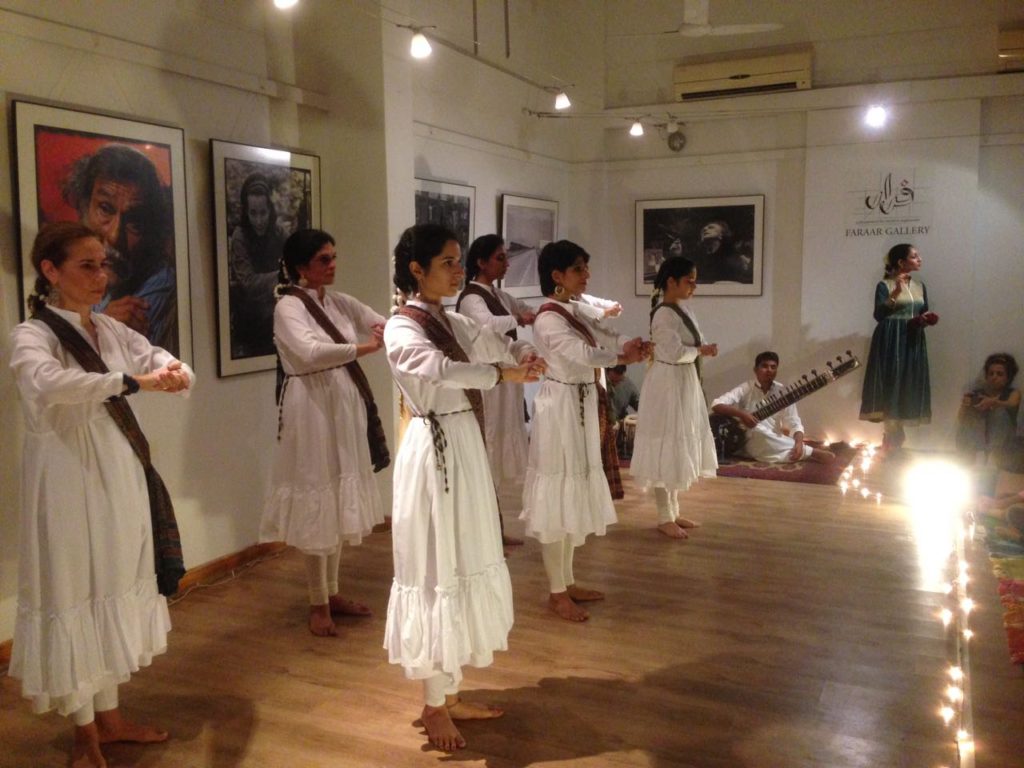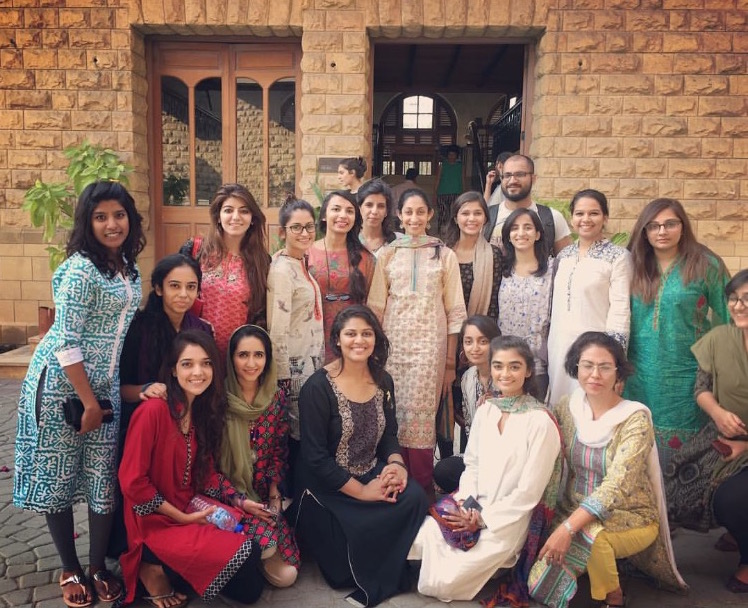
In a time where hatred and violence are a common occurrence abroad and in the U.S., I believe that artists play a critical role as cultural ambassadors and social change-makers. Through the art created and shared, and the interactions developed with audiences and students near and far, we can help shift perspectives and perceptions of the world today—in a way that both challenges and enlightens us alongside our audiences.
In January of 2016, I embarked on my first solo dance tour to Pakistan, and since then I have spent almost three months there in less than one year. I have been overwhelmed by the positive, warm responses I’ve received through performing and teaching. I continue to receive invitations to return since my first visit, and I feel honored and humbled to be part of the artistic landscape of Pakistan.
Over the course of a three part series, I will share my experiences and observations. With each visit, I’ve been able to deepen relationships, increase awareness of Kathak (classical dance of South Asia) as an art form, and not only represent myself as a Pakistani Muslim American woman performing and teaching dance, but also influence multiple generations to rethink their perspective on dance and dancers. And yet, along with the wonderful outcomes, I’ve also come to better understand the history of dance in Pakistan and how politics and extremism has and continues to determine dance in daily Pakistani culture.
Throughout my time in Pakistan, I’ve used social media to share the work that I’m doing. It’s been wonderful to see the response from friends and family in the U.S. as well as in Pakistan. It’s been a reminder of how technology has brought our world much closer together; when used authentically, in my first-hand observations, social media dispels stereotypes and changes perceptions about the people of Pakistan.
Through sharing my experiences I hope to invoke a sense of desire and responsibility that we, as artists and citizens of the world, have in reclaiming our place as a unified human race working together to better our world in the present and our future.
Why Pakistan? Why now?
I have performed and taught Kathak throughout the U.S. and India, first as a member of the Chitresh Das Dance Company, and now as a solo artist. My parents were born in India and moved to newly created Pakistan just after Partition when they were two years old, living there until they married and moved to the U.S. in 1971. Our family went frequently when I was a child so I became familiar with the culture, the food, and now the language—but I was nonetheless unsure how I would be received as a dancer in Pakistan. Even with these unknowns, a voice inside me kept saying, “Now’s the time. Just go. You’ll never know how you/it will be received unless and until you go to Pakistan.”
And so, my first trip, not knowing if there would be other visits, was planned. As I began to reach out to my personal contacts, they began to connect with people presenting performances, with whom they shared my information. I was pleasantly surprised to receive multiple invitations to perform and teach, resulting in six performances. In this first trip, I taught Kathak for multiple schools and organizations in the three major cities – Karachi, Lahore and Islamabad.

Pakistan – a brief history
In addition to sharing my own experiences, I would also like to provide a brief outline of recent political underpinnings that have shaped Pakistan. This context is important in creating a non-judgmental approach to Pakistanis and furthermore understanding attitudes towards dance.
When India gained its independence from the British in 1947, the country was divided into India, West Pakistan and East Pakistan (later to become Bangladesh)—based on religious borders and boundaries to create an Islamic nation of Pakistan. This forced migration resulted in the world’s largest mass refugee crisis where up to 25 million people were uprooted and nearly 2 million died in the violence that accompanied Partition.
As Pakistan developed its infrastructure in its first two decades as a nation, music and dance were a beloved presence in the social and cultural fabric. In 1966, the PIA Arts Academy was established in Karachi under the Pakistan International Airlines corporation, and with a heavy emphasis on dance programming. Dance classes were conducted along with performances for people living in and visiting Pakistan, especially at the various embassies located in Karachi.
Upon a military coup in 1977, General Zia-ul-Haq became the President of Pakistan, ruling from 1978-1988, institutionalizing military and Sharia Law, religious law derived from religious prophecy. This had a profound impact on the arts, and dance in particular. According to celebrated Pakistani artist of dance and theater, Sheema Kermani,
“It was a very difficult time for all of us to live through. As far as performing arts was concerned, all dance was banned. And the women who were in the arts bore the harshest brunt of it all. They were the most targeted. So when all this started happening, everyone began leaving the country. There was a mass exodus of talent from here.” (Interview with Samaa TV, August 30, 2016)
This was undoubtedly the most oppressive era in Pakistan’s history, and in many ways, though almost 30 years have passed since Zia-ul-Haq’s death in 1988, the nation and its people still suffer from the institutionalized conservatism once forced upon them.
Who’s dancing now?
During the decade of Sharia Law, Pakistanis were fearful of having any connection to dance—due to claims of dance being “un-Islamic” and the belief that women should not publicly display their bodies. Many artists had either left the country, or stopped teaching and performing. Children were born, and in their most formative years, had no idea that dance was part of their culture. They never missed it because they never had it.
A whole generation went untrained and uninformed about dance and music. Many adopted a conservative religious mindset including the notion that dance had no place in Islam and thus in the fabric of Pakistani culture.
It took time for artists to feel secure promoting their art form publicly, and to regain the trust, confidence in themselves and from others, and an interest in dance by others as well. Sheema Kermani is one artist who continues to negotiate creating work in Pakistan. She had remained steadfast in developing her craft as an Odissi and Bharatanatyam (other forms of classical dance) dancer during the decade of conservatism in 77-88, and also developed a theater arts organization, Tehrik-e-Niswan (meaning ‘feminist movement’) in Karachi. SheemaJi (respectfully) has been working for the past 35 years for the promotion of quality theatre in Urdu (language of Pakistan) and for women’s development through theatre and media in Pakistan.
“I just felt that if I also leave [Pakistan] then dance will die. And I took it on myself to continue it and not let it die. However it may be considered subversive, I was determined to continue doing it,” said SheemaJi when asked about the decade during Zia-ul-Huq’s rule.
Pakistan in the present
Pakistan’s history and current instability (from targeted and random acts of violence in the overall region), continues the uphill battle for dance artists to gain respect and complete acceptance as performers and teachers. Even 10-15 years ago, commonly occurring violent acts such as carjacking threatened safety on a daily basis; family and friends had all more recently assured me that the overall tension had subsided—it was a relatively safe time to come to perform and teach.
Thanks to artists like Sheema Kermani, and leadership shifting to more moderate approaches, the environment in relation to dance is not as oppressive as it once was but I still didn’t know what to expect. The idea of dancing in Pakistan felt personal, political and emotional. I felt the pressure of representing Kathak, the U.S., my GuruJi’s training—that somehow I was even bridging the divide between India and Pakistan, and that perhaps I could encourage an openness to dance and Kathak specifically.

At first I had a number of questions and doubts. Was it safe for a woman to dance in public? What labels were being placed on me for being a daughter of former Pakistani citizens, now returning as a professional dancer? Would I be ridiculed for my American accent? What aspects of Kathak should I perform, fearing I would do something “too Hindu” provoking anti-Indian sentiments? What were the musicians going to be like— would they give me respect as a female, as a dancer? How would I connect with these musicians—based on cultural, language and possibly gender based judgements?
All of these questions and concerns have been met with resounding positive outcomes. From the first time I rehearsed with an ensemble of Pakistani musicians, to teaching groups of men and women—most of whom had never taken a dance class, to performing for audiences of multiple generations, people have been excited, appreciative, extremely respectful and encouraging. I’ve been invited to teach workshops to students of Sheema Kermani, and to perform and teach at some of the most prestigious festivals and universities throughout the country.
I will continue to share specific experiences in the remainder of this three part series. One main outcome has been my increasing desire to continue performing and teaching in Pakistan. Another is the enthusiasm from audience members and students alike. There have been some extreme high points and some moments of frustration; I have gained the most by recognizing the potential for dance to flourish as an art form and vehicle for positive, peaceful change in Pakistan. After my first performance in Karachi, one audience member posted on Facebook,
“It was pleasure meeting with Ma’am Farah Yasmeen Shaikh who is great Kathak Dancer, she graced the event with her performance at T2F, Karachi. We need women like her to dispel darkness over Muslim population based in US and across world, indeed Art is an instrument for social change; we must inject liberal spell in the heads of those who are gobbling up this innocent earth.”
I am humbled by his comments, and more-so by his faith in me to continue “dispelling darkness”. I certainly intend to keep trying, and hope you will join me.

